Updated: February 2025
This post may contain Amazon Associates affiliate links, that I may earn small amounts from. See the bottom of this page for more details.
SYMPTOMS AND DIAGNOSIS:
Ehlers Danlos can be considered an invisible disability, and is very hard to explain to others. There is no cure for it. For some cases, it becomes a visible disability because some people do need wheelchairs, canes, and other mobility or accessibility devices such as gadgets to help open jars and such.
Various pronunciations are used, but the official one seems to be AY-LERS DAN-LOSS.
I’m discussing it on this page to raise awareness of this under-diagnosed health issue and share some non-toxic treatments (none of this is medical advice, nor is it an extensive deep dive.) This is meant to be an informative, introductory overview with my personal experience included.
Many people with EDS are misdiagnosed or never diagnosed at all due to a lack of awareness (even by doctors). That is why it is so important to spread the word so more people can be diagnosed and treated.
The Ehlers-Danlos syndromes (EDS) are a group of 13 connective tissue disorders. It’s important to remember that connective tissue is throughout your entire body, therefore the impacts can be so widespread. The deficiency is in the collagen production/quality/quantity at a cellular level. Basically, not enough or poorly made collagen so it’s not as functional as it is supposed to be. Taking any kind of collagen supplement is unlikely to help, as inside the body of someone with EDS, the collagen will be broken down and used to make new collagen, which will still be faulty as our bodies do not properly make collagen. It can be difficult to build muscle as well.
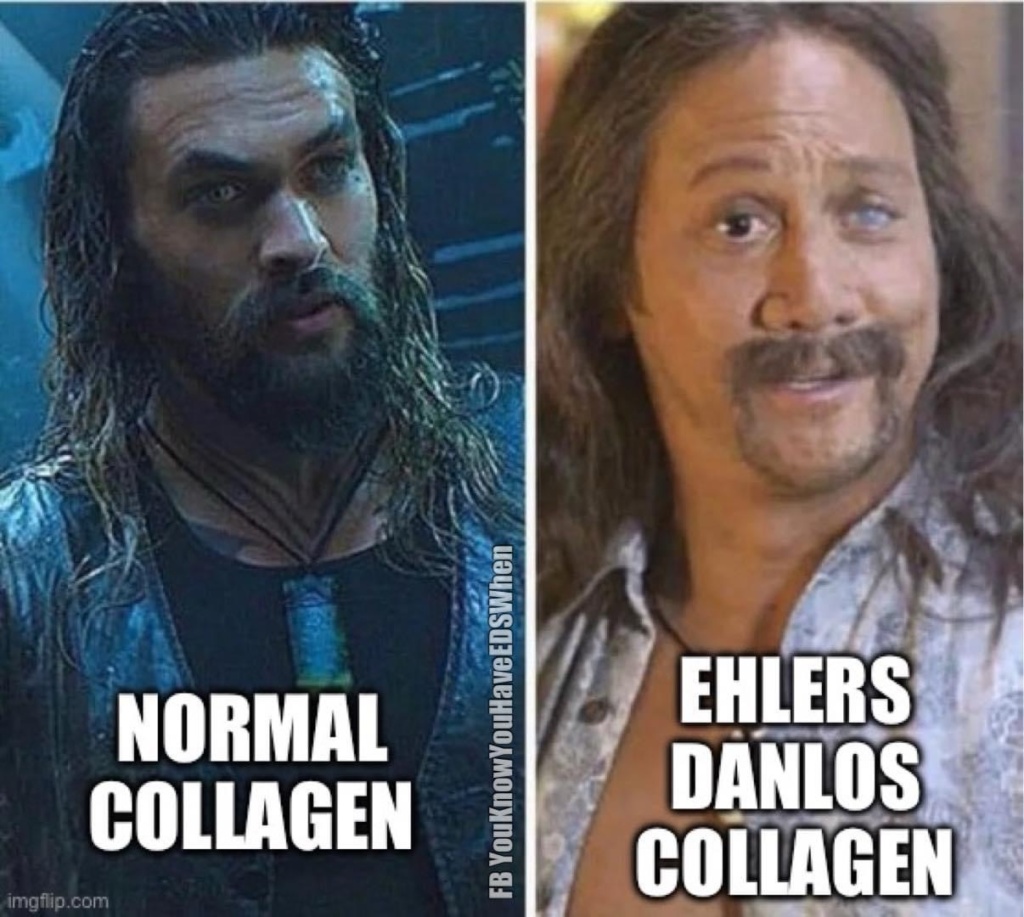
Animals can get Ehlers Danlos too, and this is what they look like:

EDS can be painful, all the time. Joints can hurt because of how unstable they are, you have micro tears, minor subluxations, and mild demyelination, your muscles are working twice as hard to make up for your unstable joints, and so on. Most of us live with daily pain that’s somewhere between a 5-10 on the pain scale. Even things like handwriting can be more challenging.

Each type of EDS has its own set of features with distinct diagnostic criteria. Some features are seen across all types of EDS, including joint hypermobility, skin hyperextensibility, and tissue fragility (source).
Hypermobility spectrum disorders (HSD) are connective tissue disorders that cause joint hypermobility, instability, injury, and pain. Other problems such as fatigue, headaches, GI problems, and autonomic dysfunction are often seen as part of HSD (source).
Hypermobile EDS (hEDS) and, less commonly, hypermobility spectrum disorders may also be associated with anxiety disorders, chronic pain, fatigue, orthostatic intolerance, functional gastrointestinal disorders, and pelvic and bladder dysfunction (source). Frequent joint dislocations and subluxations (partial dislocations) or being so-called “double-jointed” is common.
But don’t worry, it you have hypermobility, it doesn’t mean you definitely have EDS. There are a number of other criteria needed for diagnosis.
Diagnosic criteria was updated in 2017 (but if you were diagnosed before then, it is still valid). Extremely loose joints, fragile or stretchy skin, and a family history of Ehlers-Danlos syndrome are sometimes enough to make a diagnosis. Typically EDS is genetic (inherited from a parent) but there are cases where it’s de novo meaning the mutation occurred in the egg or sperm, therefore you can have EDS even if you’re parents don’t appear to.
Agent Orange can cause/ contribute to EDS.
Women are more often diagnosed with hEDS because the symptoms are less evident in men due to testosterone making joints stiffer & estrogen making them looser. Other types of EDS may be easier to spot in people of any sex because they don’t primarily rely on diagnostic criteria which is affected by hormones. EDS symptoms can get worse during hormonal period cycles because of the hormone relaxin that is released.
Asians and Africans are more likely to be hyper mobile.
Genetic tests on a sample of your blood can confirm the diagnosis in rarer forms of Ehlers-Danlos syndrome and help rule out other problems. For hypermobile Ehlers-Danlos syndrome, the most common form, there is NO genetic testing available (source) but it can be diagnosed though a physical exam. Here is a video that describes the main aspects of different types of EDS.
If you think you have EDS and are looking to get diagnosed, here is a video with more information. Here is an article about why it can be hard to find doctors to diagnose or treat ESD. And a document with tips of what to ask different types of doctors, if you have EDS.
EDS is considered a rare disorder, but I think with better screening and awareness, a significantly higher amount of people would be diagnosed.
Here is a video of people describing their EDS symptoms. Some of them might surprise you!
I’m not sure where this image originated, but it is an overview of symptoms in children. I’d add low muscle tone to this, for example, flat feet with ankles and/ or knees that roll inwards.

CO-OCCURRING CONDITIONS AND WHY DIAGNOSIS IS SO IMPORTANT:
Diagnosis is important because people with Ehlers Danlos can suffer a reduced quality of life, and not even know why. There are also dangerous implications and co-occurring conditions. Here are just a few (almost all of which I personally have experienced):
-High likelihood of having ADHD, anxiety, depression, autism, etc.
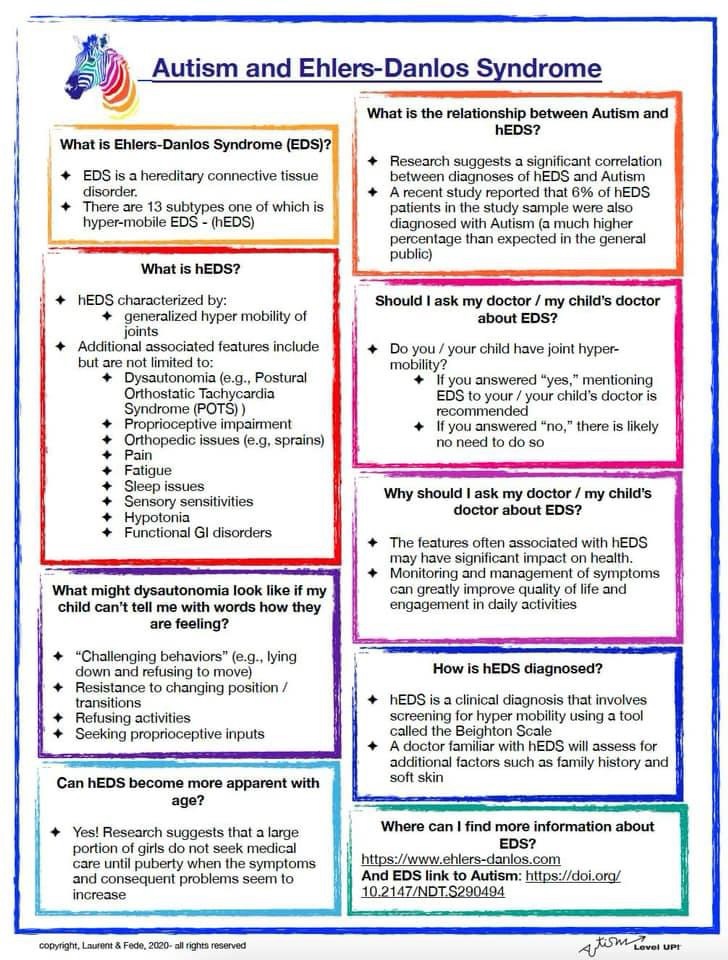
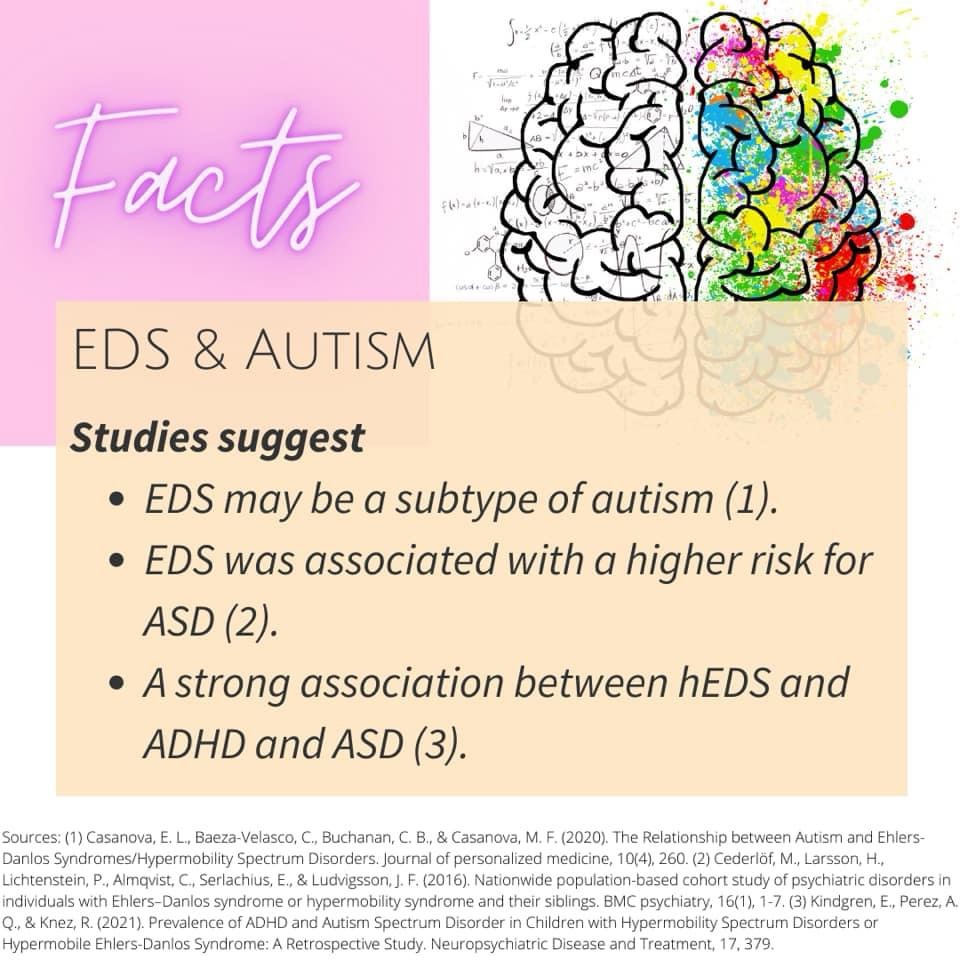
-Chronic fatigue and ‘brain fog.’ People with EDS or HSD may find themselves feeling confused, unable to process information, or forgetting things.
-Significant sleep problems.
-Eating disorders.
-Small fiber neuropathy, which causes more intense pain, is frequently comorbid and routinely misdiagnosed as fibromyalgia in EDS patients. Many EDS patients feel we have both have a high pain tolerance but also feel pain more strongly. This may be because our nervous system can be disregulated, which can cause hypersensitivity and create an heightened perception of pain. But people who suffer from chronic pain also tend to get used to pain and build up tolerance. Many people with EDS are also neurodivergent. This can cause you to feel pain more intensely or to have a very high pain threshold due to differences in sensory processing. Here is a scientific journal article about pain and central sensitization in EDS patients.
-Higher likelihood of autoimmune problems.
-One of the most common co-occurring conditions with some of the most disabling effects, yet least often diagnosed is any form of MCAS, MCAD or Mast Cell Activation Disorders. These cause mast cells to release an inappropriate amount of chemicals, such as histamines, into the body. This causes allergy symptoms, like having “extra” or “hidden” non-food and chemical “allergies” that traditional allergy testing cannot find. It also causes wide range of other symptoms. This is often mis-diagnosed as Multiple Chemical Sensitivity or porphyria.
–Research has shown that hEDS is associated with rheumatologic disease including increased prevalence of arthritis and Ankylosing Spondylitis.
-Dysautonomia (a group of disorders that affect the autonomic nervous system, which regulates functions we don’t consciously control, such as heart rate, blood sugar, blood pressure, sweating and body temperature, can cause fainting, something I can personally tell you is very scary.
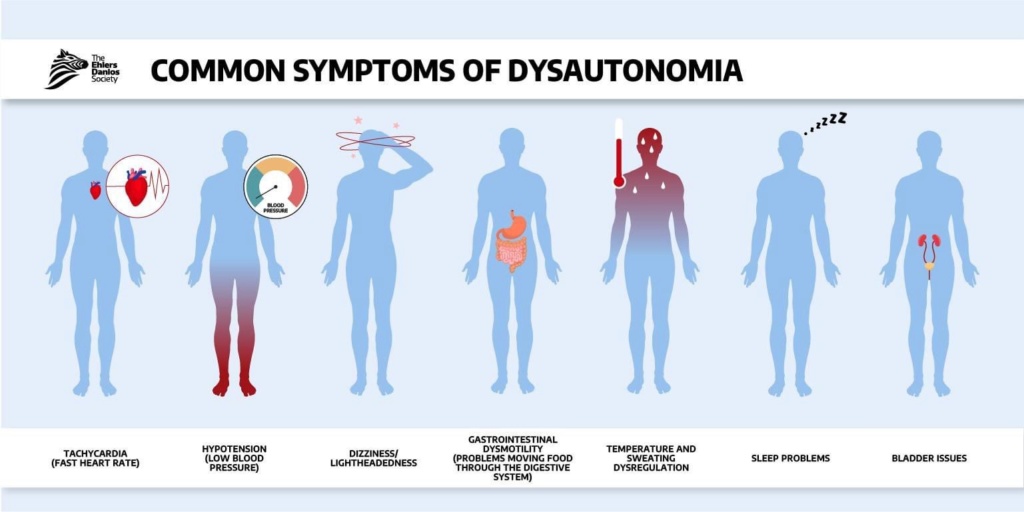
-Postural Orthostatic Tachycardia Syndrome (POTS) is very common in EDS patients and is a blood circulation disorder and a form of dysautonomia. The key characteristics of POTS include the exaggerated increase in heart rate when standing. Symptoms of POTS include but are not limited to lightheadedness (occasionally with fainting), difficulty thinking and concentrating (brain fog), fatigue, intolerance of exercise, headache, blurry vision, palpitations, tremor and nausea.
-Chronic Inflammatory Response Syndrome (CIRS) is a complex and chronic biotoxin illness. CIRS is a collection of symptoms that affects multiple systems in the body. The most common symptoms of CIRS are fatigue, depression, brain fog, digestive problems, headaches and other aches, joint, muscle, and abdominal pains, blurred vision, cramping, and more.
-Gastroesophageal reflux disease (GERD) occurs when stomach acid repeatedly flows back into the tube connecting your mouth and stomach (esophagus). Many people experience acid reflux from time to time. However, when acid reflux happens repeatedly over time, it can cause GERD.
-Slow and poor wound healing.
–Endometriosis, PCOS and menorrhagia (very heavy menstrual bleeding; I had an episode of this in my 20s).
-Increased risk of miscarriage, pregnancy complications, and diastasis recti (separation of abdominal muscles).
-Metal and other environmental allergies, especially nickel sensitivity.
-Lipedema/ Lymphedema
-Myopia (often severe), macular degeneration, astigmatism, Strabismus (crossed eyes) or wandering eyes from likely weak eye ligaments.
-High likelihood to be resistant to local anaesthetics, such as topical creams or injections. This can make dentistry work, and other treatments, very challenging and painful (more information at this link).

Here is a link with a much, much longer list of possible comorbidities.
Keep in mind that everyone is affected differently.

TREATMENTS:
I’m still learning about this and hope to add more later to this section.
Unfortunately for connective tissue disorders such as EDS: There is no cure for them! And further, there is no treatment for the root of the problem. For example, people with blood clotting disorders can take blood thinners and as long as they take them, the issue with their blood is remedied.
There is no such treatment for EDS, for which a fundamental issue is an inability to use collagen correctly. Even if we try to take collagen supplements, our bodies won’t know how to use it and continues to make defective collagen throughout every cell of our bodies including organs, brain, joints, skin and even bone, which is really just hardened connective tissues. There is NOTHING that can be done to fix that.

The central goals of seeking treatment/ therapies are managing symptoms, preventing joint injury, and educating patients about their condition.
A healthy, nourishing diet is essential, including proteins and healthy fats. Avoiding simple carbohydrates and sugars can prevent inflammation. Avoiding toxicants in general can also reduce the burden of toxic overload on the body.
Vitamin supplementation can be helpful, including B vitamins and amino acids. Here is a great scientific article with more information including this table which outlines which supplements and diet protocols might be most beneficial for people with EDS. Methylated vitamins may be a beneficial type for EDS. Desiccated beef liver has a very bioavailable form of copper, which is needed for healthy connective tissue.
Exercise is very beneficial and can help manage symptoms when done correctly. Functional strength training is excellent as it helps our muscles do the work our joints can’t. The Muldowney protocol is a great place to start. “Living Life to the Fullest with Ehlers-Danlos Syndrome” is a book that explains it. Amazon Associates link: https://amzn.to/3P4Dxlk
For cardio, if you have POTS, you’ll need to be careful not to overdo it and stay within certain zones. The Levine protocol has great guidelines for this. The key with any exercise is to never overdo it, never hyperextend, and give yourself breaks to recover.
Use caution with activities such as dancing and sports. Information from the London Ballet since the 1969s suggest that children entering the school often have hypermobility, but those children don’t usually make it to the highest levels. The same is true for kicking and throwing sports. This shows that hypermobility can be an early benefit but a burden later.
Based on limited evidence, patients with hypermobile EDS/hypermobility spectrum disorders may benefit from physical and occupational therapy, psychological support, and self-management (source).
The Cusac Protocol is an alternative treatment plan involving supplements. I haven’t tried it all but I have tried some of it.
Here is a video about trigger point massage techniques that can be helpful. A tool that I find helpful for massage is this Body Back Buddy. It is made of hard plastic, which is a good choice toxicity-wise. Amazon Associates link: https://amzn.to/3YBzK1U
This isn’t specifically about EDS but since pain is ubiquitous with it, here are natural pain relief strategies:
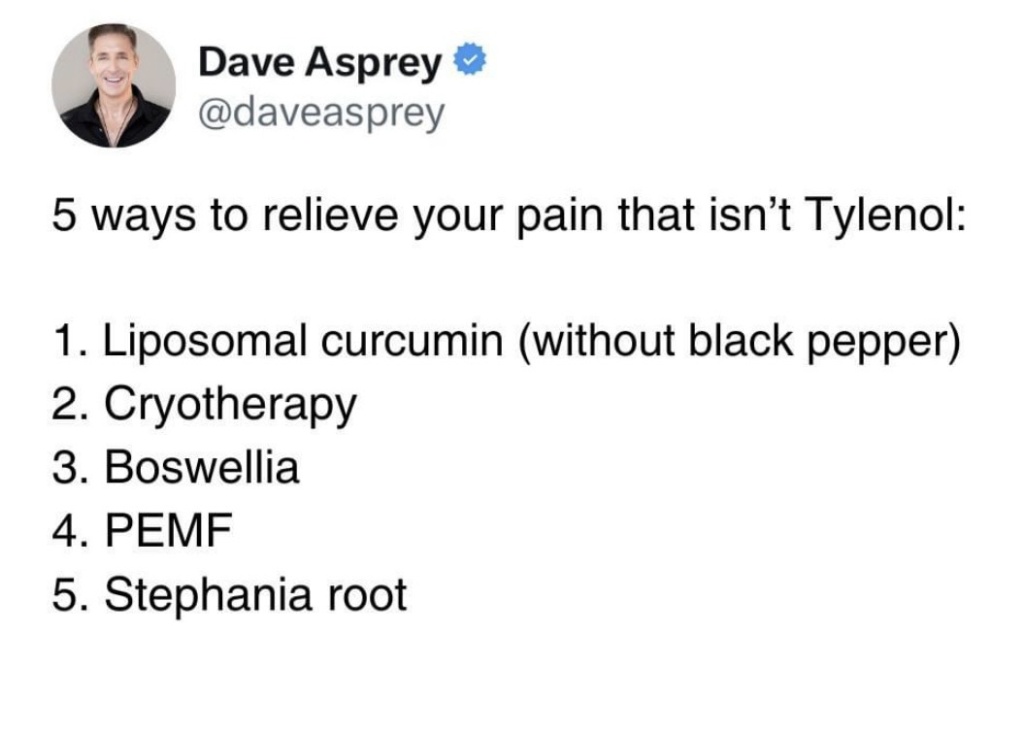
Here is an amusing summarization of hEDS, from this video:

MY STORY AND MORE ABOUT CONNECTIVE TISSUE
When I was diagnosed with hEDS (hypermobile EDS, formerly known as Ehlers-Danlos Syndrome III, hyper-mobility type) I was 32 years old. It was a complete surprise as I had previously never even heard of it.
I was given an appointment with a geneticist after having a miscarriage (followed by complications and possibly another miscarriage) and wasn’t expecting any answers about that, but I did ask for an MTHFR test. The doctor didn’t want to give me that, but as she asked me questions about my health issues and family, I think she became intrigued and wanted to help.
She called in another doctor, who asked me more questions and had me demonstrate some hypermobility exercises and made the diagnosis. My soft skin was the final deciding factor… it was a little odd as they nodded to each other while touching my arms.
Although it was nice to have some kind of diagnosis, they didn’t really have any recommendations of what to do differently as I already took vitamins and drink lots of water.
After that, I told my chiropractor at the time since I thought it would be very relevant to my chronic neck and back pain issues. However, that chiropractor was extremely dismissive. He literally said “so you have stretchy skin? So what?”
I have a feeling that many people with EDS experience situations like that, because when you google Ehlers Danlos Syndrome, many sites list hypermobility and stretchy skin as main symptoms, without mentioning the myriad of internal (including organ dysfunction) and mental issues people with EDS often suffer from.
Connective tissue provides support to many body parts such as the skin, muscles, ligaments, and bones. The fragile skin and unstable joints found in patients with EDS are the result of faulty or reduced amounts of collagen (which cannot easily be remedied).
This explains many of my symptoms: Degeneration of knee cartilage (discovered by doctors and confirmed by x-ray when I was in my 20s), restless leg syndrome, scoliosis, flat feet, and almost everything listed in the “comorbidities” section above.
A somewhat disturbing analogy given by the doctors who diagnosed me: If one builds a house with bad materials, with cheap nails or only half the wood required, problems will arise. Some problems are more likely to show up than others, but because the bad or missing materials are everywhere and not necessarily visible, it can be surprising where some problems occur.
Since my diagnosis, I have not received any treatment for EDS. None of my doctors have seemed familiar or helpful with it. And so until recently, I believed that chiropractor who said “so what?” and figured it wasn’t a big deal and the issues were isolated to my joints.
I have been on a long journey of trying to figure out reasons for the other things that are wrong with my health. Only recently have I began to learn more and realize that EDS may be the reason for it all!
A more recent chiropractor I’ve seen is alarmed by the amount of degeneration in my neck at my age. I will need lifelongy care just to try to mitigate against bone fusion and bone spurs. My biological dad has been in and out of a wheelchair due to an arthritic disease called Ankylosing Spondylitis (which I’m also at risk for) and I’m scared I’ll end up like that.
For now I’m thankful for the health and mobility I do have, as many people with EDS need wheelchairs or other mobility aids. I plan to continue to learn and try more treatment strategies.
This shows the hypermobility of my arm:

Some things that I have found to be helpful for me are avoiding high impact exercise such as running. And although I love group fitness classes, they aren’t tailored to individuals, and I find that I end up doing movements that overexert me. I also have a hard time not “showing off” a bit with my flexibility in yoga classes.
I wrote a guide post for maintaining fitness despite chronic health challenges.
HELPFUL SUPPLEMENTS:
Mast cell stabilizers such as Luteolin are said to help reduce MCAS reactions, but some people have reported they had to take a high dose to see results. https://amzn.to/3VGNS9a (all links are Amazon Associate links)
Glucosamine: https://amzn.to/4cGJXQi
RESOURCES:
The Ehlers Danlos Society has a helpline and support groups.
Ehlers Danlos Support UK has a helpline, support groups, and a “how you can help” page that includes a “Dazzle Walk” awareness fundraiser I participated in.
The pink zebra graphic I used on my title graphic was seen on an Ehlers Danlos awareness page here (though the pink graphic doesn’t have a watermark so I’m not sure who created it). There are many more pages and groups on social media that can be helpful.
Zebra Club is an exercise program made for people with EDS by a movement therapist who has EDS. It’s all online.
Here is a great, easy to read Facebook post all about EDS.
This is a helpful storybook for kids called “Why Does Mommy Hurt? Helping Children Cope with the Challenges of Having a Caregiver with Chronic Pain, Fibromyalgia, or Autoimmune Disease.” Amazon Associates link: https://amzn.to/3D6Cbzs
Here is another book that looks helpful:
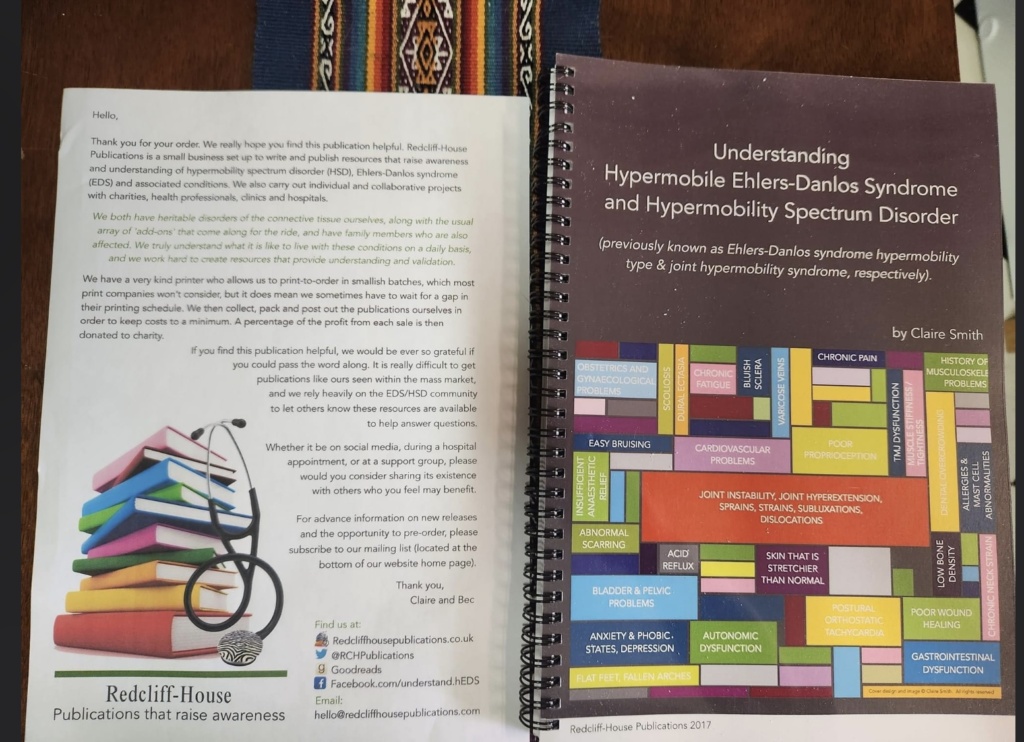
RECIPE SHARING GROUP:
I created a recipe sharing group by request because there are no other recipe sharing groups specifically mentioning conditions including Chronic Inflammatory Response Syndrome (CIRS), Postural Orthostatic Tachycardia Syndrome (POTS), or Mast Cell Activation Disorders (MCAD or MCAS).
Other Special Diets Also Welcome:
Vegan, Keto, Allergies, Intolerances/ Sensitivities, Organic, Anti-Inflammatory, Etc. Or simply if you’re interested in healthy recipes.
Many recipe sharing groups have restrictive rules, but we aren’t doing that here! Share text, links, or pictures, whatever works for you! Just be kind, supportive, respectful and understanding that different foods work for different people.
Here is the new group link. Please join and share! https://www.facebook.com/groups/425339623150673/?ref=share_group_link&exp=7ffb

Please follow my Facebook page. Thanks!
Here is another old pictures of me that shows my hyperextended arm. I’ll try to add more pics at some point.

***Thank you for visiting Clean Green Toxicant Free! I started this site simply because I want to help people and share information. I dig deep and seek the most truly non-toxic products, without bias. I am not paid to write anything and I don’t sell anything. In 2022 I became an Amazon Associate, which does NOT bias my recommendations. I may earn small dividends from purchases made after clicking my clearly labeled amazon affiliate links (even if you don’t buy those specific items), which covers the costs I pay to maintain this site. More info is on the About This Website page.***
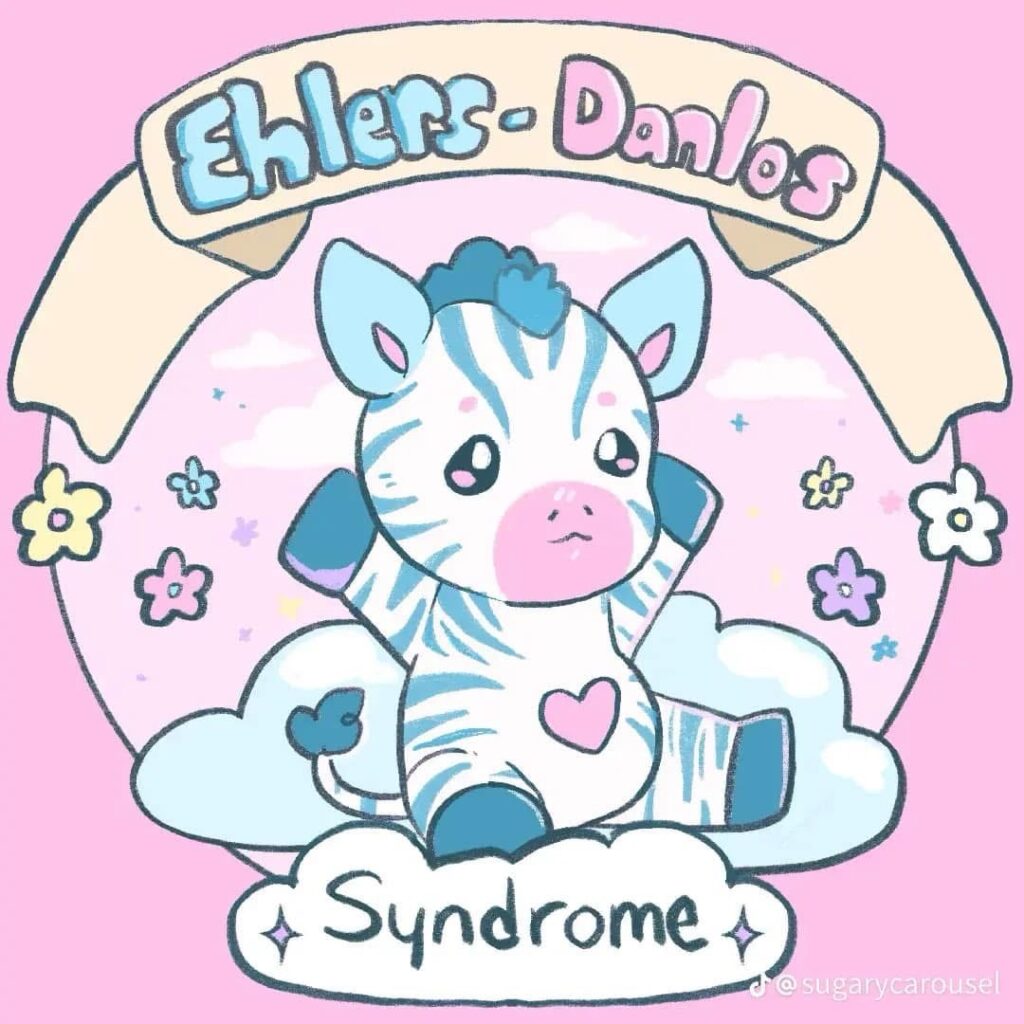

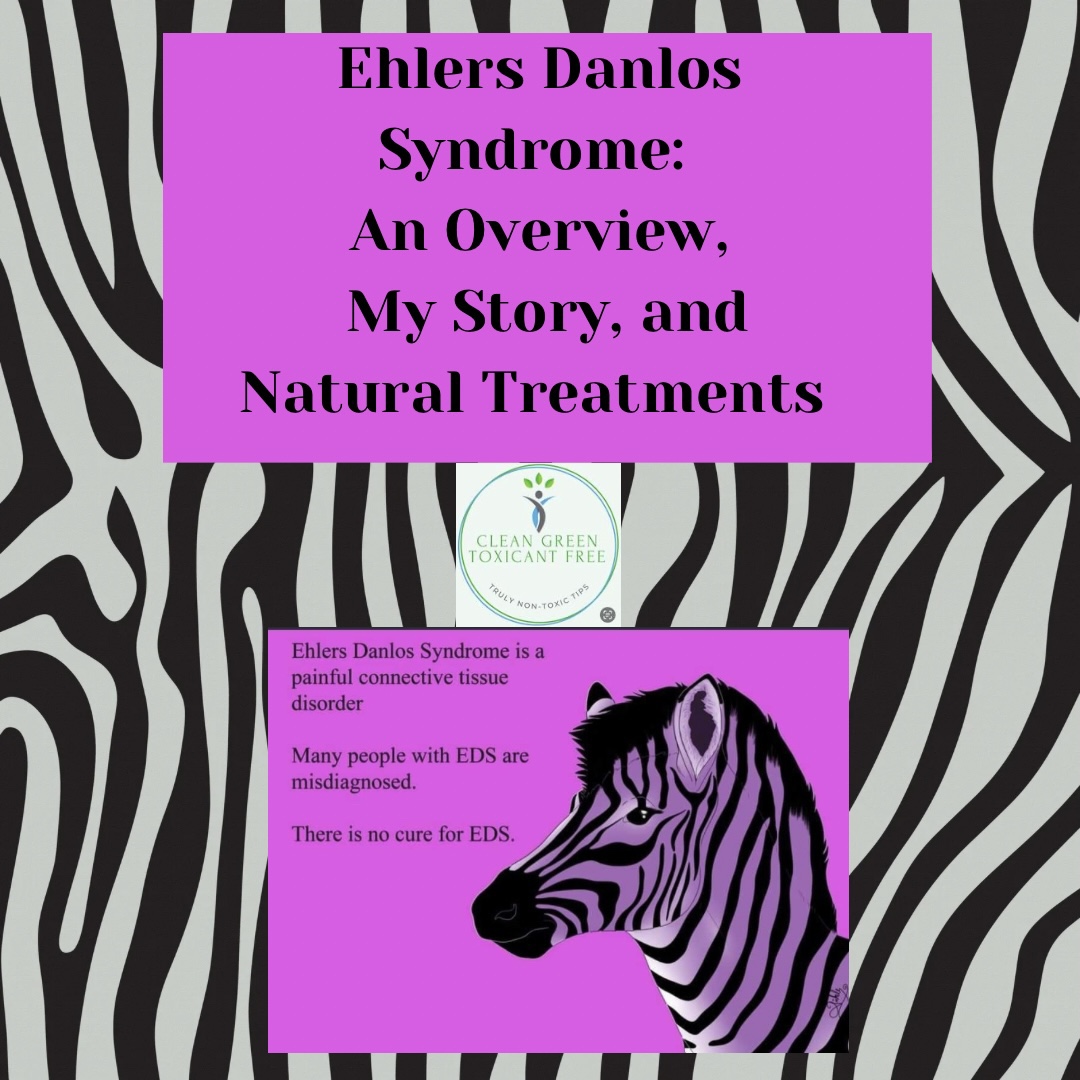
I appreciate you sharing this blog post. Thanks Again. Cool.